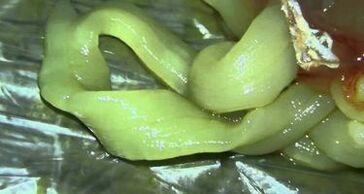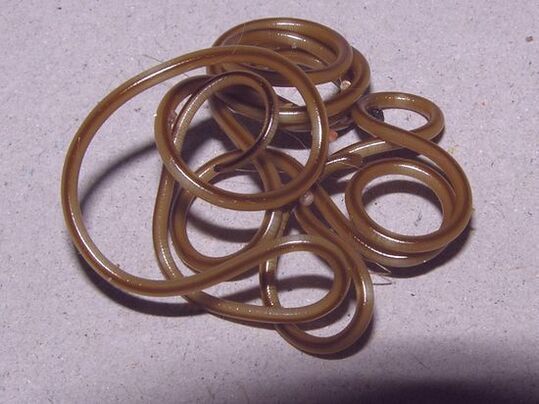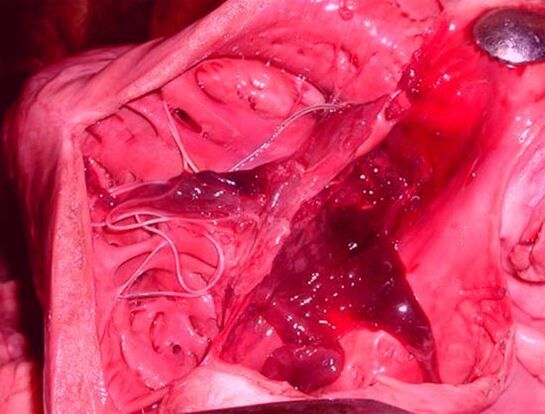
It is healthy to live in the world - the parasites in the body interfere with this. These are the lower plant and animal forms, living at the owner's expense. Translated from Greek, they mean - freeloader.
Going through parasitism, they can be external and internal.
Parasites living in the human body are divided into flatworms and roundworms.
The dishes are divided, in turn, into trematodes and cystodes.
Roundworms are also called nematodes.
Nematodes living in the human body

What parasites live in the body, first of all nematodes - they reach a great length and have the shape of an earthworm, hence the name - roundworms, these are:
- roundworms;
- pinworms;
- hookworms;
- trichinella.
Round worm
One of the most common nematodes is a parasite, in some cases reaching a size of 45 cm. The female produces 200, 000 eggs, and this process occurs regardless of the presence of a male in the host's body. With the feces, the eggs fall into the soil where, when favorable factors arise, they turn into larvae. You can get infected with this helminth through dirty hands and unwashed vegetables, fruits and berries.
Signs of infection: nausea, salivation, loss of appetite. In the presence of a large number of roundworms, serious consequences can occur, rupture of postoperative sutures, the occurrence of pancreatitis. Roundworms are especially dangerous for pregnant women - their penetration into the fetus is possible.
Pinworms
Small worms, measuring up to 10 mm, are infected with it mainly by children, more often in kindergartens. A sick person becomes the cause of infection, and if the rules of personal hygiene are not observed, the possibility of infection increases significantly. Signs of the appearance of worms:
- nighttime itching of the anal area;
- decreased performance;
- sleep disturbances;
- nervous disorders.
The presence of pinworms does not threaten the life of the patient, but it is quite unpleasant and causes dysbiosis.
Hookworm
The 20 mm parasite has a pink color, gives less manifestations, but the resulting damage is colossal. Its oral cavity has teeth and plaques with which it eats away at blood vessels. The larvae enter the body through the skin of barefoot walkers.
The main task of the larvae is to enter the human mouth, from where, swallowing saliva, they descend into the intestines, where adult helminths are excreted. They feed on human blood, which results in anemia. The threat is posed by their wastes, which poison the body. The signs of the presence of helminths are: persistent bronchitis, dermatitis, nausea, abdominal pain, digestive disorders. The heart suffers from this parasite - myocarditis can appear.
Trichinella
The female worms grow up to 4 mm, the males are smaller. They die in the external environment and are only viable inside the body. The source of infection is uncooked animal meat. Through the blood vessels, the parasites spread to all organs, take root and can live peacefully for 20 years.

The most common signs of infection are:
- an increase in the blood test for eosinophilic leukocytes;
- an increase in temperature to 40 ° C;
- muscle pain;
- conjunctivitis and swelling of the face.
Trematode parasites
Helminths, small in size, have a flat body on which there are 2 suction cups. Most are hermaphrodites. An intermediate host is necessary for development.
Paw
Helminth - hermaphrodite, grows up to 14 mm, affects the bile ducts. The eggs, after entering water bodies, settle in mollusks, where they develop into larvae, and then the larvae settle on the scales of the fish. If at this time a person eats poorly fried fish, he can get infected with this parasite.
In the body of its final host, a human, the fluke is introduced into the duodenum, where the larva transforms into an adult helminth. Water bodies are infected with fluke by people who eat fishery products and work on water boats (their waste gets into the water).
Schistosomes
Helminths, having heterosexual individuals, needle-like in appearance. A pair of parasites produce up to 3000 eggs in 24 hours. A person becomes infected by bathing or with contaminated water. In the lungs and blood vessels, the larva becomes an adult. After that, spawning takes place in the intestine.
In the presence of schistosomes, we observe:
- stomach ache;
- violation of appetite;
- anemia;
- go from diarrhea to constipation;
- weightloss;
- violation of the cycle in women;
- impotence in men;
- decrease in school performance in children.
When introduced into the nerve fibers, the development of paralysis, brain damage is possible.
Where can helminths settle
Often people are interested in where the parasites live in the human body?
The localization is due to the type of host that entered the body of the "parasite". Most often, they settle in the digestive organs, in the lungs, heart, liver.
The human body, where the parasite lives, weakens and begins to suffer from various diseases. It is therefore not difficult to determine that the parasites live in the body. You just need to be more attentive to yourself, and if the slightest suspicion arises, you can not postpone a visit to the doctor.

In order for the body in which the 6-letter parasite lives to heal and become healthy again, it must adhere to the rules of hygiene, do not drink raw water and do not eat undercooked meat. Only then can the risk of infection be reduced.
It's great to live in this world and you don't want to think about parasites in the human body, but you have to. After all, one in two people on Earth is infected with worms. The organism in which the parasite lives is a field of miracles, which will occur. But trusting fate is the lot of the weak.



























